Darya-i-Nur
 The famous Darya-i-Nur or Sea of light is the largest pink diamond of the world and takes the first place among the diamonds in the National Treasury of Iran. This famous diamond along with its mate, the Kooh-i-Nur, or Mountain of Light, perhaps due to similarity of names, has always come together in history, although there is no similarity in cut or color between these two diamonds. Both of these stones were in the possession of Nadir Shah. After his death, Ahmad Shah Durrani took Kooh-i-Nur ti Afghanistan. After Ahmad Shah, it passed on to Shah Shuja, and after the defeat of Shah Shuja by Ranjit Singh the Lion of the Punjab, it passed into his possession. Later East India Company obtained it and presented it as a gift to Queen Victoria. It is presently in the Queen Mother’s Crown in England.
The famous Darya-i-Nur or Sea of light is the largest pink diamond of the world and takes the first place among the diamonds in the National Treasury of Iran. This famous diamond along with its mate, the Kooh-i-Nur, or Mountain of Light, perhaps due to similarity of names, has always come together in history, although there is no similarity in cut or color between these two diamonds. Both of these stones were in the possession of Nadir Shah. After his death, Ahmad Shah Durrani took Kooh-i-Nur ti Afghanistan. After Ahmad Shah, it passed on to Shah Shuja, and after the defeat of Shah Shuja by Ranjit Singh the Lion of the Punjab, it passed into his possession. Later East India Company obtained it and presented it as a gift to Queen Victoria. It is presently in the Queen Mother’s Crown in England.
The Darya-i-Nur diamond was inherited by Shahrokh Mirza, the grandson of Nadir Shah. It then came into the possession of Amir Alam Khan Khozeimeh, and later, Lotfaio Khan Zand. When Lotfali Khan Zand was defeated by Agha Mohammad Khan Qajar, this diamond came into the treasury of the Qajar kings. Nasser-ed-din Shah believed that this diamond was one of the gems decorating the crown of Cyrus (558 to 529 BC), and was very fond of it. He wore it as an armband, aigrette or as a brooch. The maintenance of Darya-i-Nur was a high, special honor bestowed upon high-ranking personages. Darye-i-Nur later entered the Treasury of National Jewels of Iran. The weight of Darya-i-Nur is approximately 182 carats, and its colors are pale pink --- one of the rare colors for diamonds. The frame is set with 457 diamonds and 4 rubies. In 1965, during the research by a Canadian team on the National Jewels, an interesting point was revealed. The famous French jeweler and traveler, Tavernier, mentions in his book, that he has seen a large, pink diamond weighing 242 carats, in the East, in 1642. he named it “Diamonda Grande Table”. The color and size of this diamond caught the attention of this Canadian team, and they believed that Darya-i-Nur and Nur-ol-Eyn were originally one stone, that later got spilt into two stones, part becoming the Darya-i-Nur, and part the 60 carat Nur-ol-Eyn that is presently mounted in Tiara No. 2 displayed in Case 26.
Crown Of Pahlavi
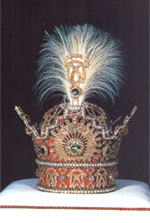 Crown used by Reza Khan and Mohammad Reza Pahlavi. This crown is made of gold and silver, and decorated with diamonds, emeralds, sapphires and pearls. The fabric of the crown is red velvet. On the 4 sides of the crown are battlement designs and also sunbursts on the four panels, totally set in diamonds. The general design is in the style of the crown of the Sassanid kings (226-651 AD). Inside the front sun design, there is a very large yellow diamond. The total number of the precious stones set in this crown is as follows:
Crown used by Reza Khan and Mohammad Reza Pahlavi. This crown is made of gold and silver, and decorated with diamonds, emeralds, sapphires and pearls. The fabric of the crown is red velvet. On the 4 sides of the crown are battlement designs and also sunbursts on the four panels, totally set in diamonds. The general design is in the style of the crown of the Sassanid kings (226-651 AD). Inside the front sun design, there is a very large yellow diamond. The total number of the precious stones set in this crown is as follows:
Diamonds: 3,380 pieces 1,144 carats
Emeralds: 5 pieces 199 carats
Sapphires: 2 pieces 19 carats
Pearls: 368 pieces, perfectly matching
Total weight of the crown is 2,080 grams.
The crown used during the coronation of the Qajar Kings, was the Kiani Crown, but Reza Khan Pahlavi was not inclined to use it. In 1925 AD, a group of Iranian jewelers, under the supervision of Haj Serajeddin (the famous jeweler who had been jeweler to the Amir of Bokhara, and had emigrated from Russia to Iran), undertook to make this crown, using selected stones from the Treasury. This crown was used in the coronation of Reza Pahlavi, held on April 25, 1926 AD, and in the coronation of Mahmmad Reza Pahlavi on October 26, 1967 AD.
Nadir Aigrette
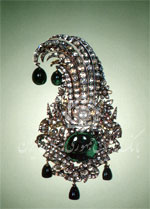 The Nadir Aigrette set with diamonds and emeralds. The central emerald is cabochon and of a very good color. 3-drop emeralds hang from the aigrette. There are 7 diamond-studded plumes on top of this aigrette. At the base of two of these plumes, there are 2 flowers and at the ends, 2 emeralds drops. On both sides of the central emerald and below the crescent, there are flags, drums, cannons, and spears. The tri-colored flags have pale rubies and emeralds. The whole aigrette is set with very good, rose cut diamonds. Reza Khan Pahlavi often used this aigrette, which weights 781 carats.
The Nadir Aigrette set with diamonds and emeralds. The central emerald is cabochon and of a very good color. 3-drop emeralds hang from the aigrette. There are 7 diamond-studded plumes on top of this aigrette. At the base of two of these plumes, there are 2 flowers and at the ends, 2 emeralds drops. On both sides of the central emerald and below the crescent, there are flags, drums, cannons, and spears. The tri-colored flags have pale rubies and emeralds. The whole aigrette is set with very good, rose cut diamonds. Reza Khan Pahlavi often used this aigrette, which weights 781 carats.
Kiani Crown
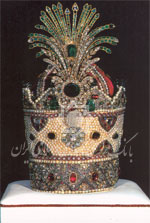 Crown of Fath-Ali Shah Qajar known as “Kiani Crown” and set with diamonds. Emeralds, rubies, and pearls. The final red stone is Aurangzib spinel. This crown was made during the reign of Fath-Ali Shah, and was used by succeeding kings. It is the first crown made in this shape after the Sassanid dynasty.
Crown of Fath-Ali Shah Qajar known as “Kiani Crown” and set with diamonds. Emeralds, rubies, and pearls. The final red stone is Aurangzib spinel. This crown was made during the reign of Fath-Ali Shah, and was used by succeeding kings. It is the first crown made in this shape after the Sassanid dynasty.
Globe of Jewels
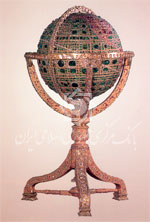 This Globe of Jewels was made in 1869 AD by order of Nasser-ed-din Shah. A group of Iranian craftsmen, ender the supervision of Ebrahim Massihi, made this globe using the loose stones of the Treasury. The net gold used in this Globe is 34.00 kilograms and the total weight of the stones is 3,656 grams. The total number of stones used is 51,366 pieces. Finding the different countries can be difficult among the sparkle of the gems, because the skill of the craftsmen was more in jewellery making than in geography. The oceans and seas are identified in emeralds and lands are shown in rubies. Southeast Asia, Iran, England and France are specified with diamonds. India is shown in pale rubies. Central and South Africa are shown in sapphires. The equator as well as other geographical lines is in diamonds and rubies.The diameter of the Globe is about 66 centimeters. The stand is of gold and studded with gems.
This Globe of Jewels was made in 1869 AD by order of Nasser-ed-din Shah. A group of Iranian craftsmen, ender the supervision of Ebrahim Massihi, made this globe using the loose stones of the Treasury. The net gold used in this Globe is 34.00 kilograms and the total weight of the stones is 3,656 grams. The total number of stones used is 51,366 pieces. Finding the different countries can be difficult among the sparkle of the gems, because the skill of the craftsmen was more in jewellery making than in geography. The oceans and seas are identified in emeralds and lands are shown in rubies. Southeast Asia, Iran, England and France are specified with diamonds. India is shown in pale rubies. Central and South Africa are shown in sapphires. The equator as well as other geographical lines is in diamonds and rubies.The diameter of the Globe is about 66 centimeters. The stand is of gold and studded with gems.
Peacock Throne(Sun Throne)
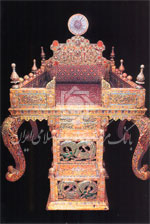 During the reign of Fath-Ali Shah and by his order, a great throne was made under the supervision of Nezamoldoleh Mohammad Hossein Khan Sadr Esfahani, the governor of Isfahan. Using gold and the loose stones of the treasury. (Early 19th century). As a design of sun encrusted with precious stones was used at the top of the throne, it became famous as the “Sun Throne”. After the marriage of Fath-AliShah with Tavous Tajodoleh, due to her name, the throne was named “Peacock Throne”. Some Iranians thought that the above throne was the same brought from India but according to the definition of Tavernier from “Peacock Throne” and their own gatherings they came to the conclusion that it can not be the genuine “Peacock Throne.” In order to confirm this view, they discussed the matter with Nasser-ed-din Shah and at last became sure that this “Peacock Throne” was constructed by the order of Fath-Ali Shah and was named after his favorite wife Tavous Khanoum or Lady Peacock as “Peacock Throne”.
During the reign of Fath-Ali Shah and by his order, a great throne was made under the supervision of Nezamoldoleh Mohammad Hossein Khan Sadr Esfahani, the governor of Isfahan. Using gold and the loose stones of the treasury. (Early 19th century). As a design of sun encrusted with precious stones was used at the top of the throne, it became famous as the “Sun Throne”. After the marriage of Fath-AliShah with Tavous Tajodoleh, due to her name, the throne was named “Peacock Throne”. Some Iranians thought that the above throne was the same brought from India but according to the definition of Tavernier from “Peacock Throne” and their own gatherings they came to the conclusion that it can not be the genuine “Peacock Throne.” In order to confirm this view, they discussed the matter with Nasser-ed-din Shah and at last became sure that this “Peacock Throne” was constructed by the order of Fath-Ali Shah and was named after his favorite wife Tavous Khanoum or Lady Peacock as “Peacock Throne”.
After the death of Fath-Ali Shah and some years later, as Nasser-ed-din Shah loved jewels, ordered to repair the throne by making some small changes in it. Therefore, some panels were added to the throne, depicting verses, which confirm the repayment of the throne by Nasser-ed-din Shah. The verses are in blue enamel on a golden background. The verses are arranged very regularly and reveal the fact that is added to the throne during its repayment. The peacock throne was kept in Golestan Place until 1360 (1981 AD). On 17/6/1360 (6th September 1981) the throne was delivered to the Treasury of the National Jewels located in the Central Bank of the Islamic Republic of Iran, to be kept in a place that it has similarity with the other pieces of the collection due to its rich accumulation of jewels. (Subject of the law approved in 1316 = 1927 AD).